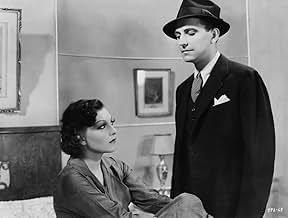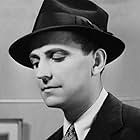Arrested when he gets into a fracas, while escorting the girl he has hitherto loved only from afar, noted ballet dancer Delphine, to her car, Danny O'Day, famous radio tenor, is late for his... Read allArrested when he gets into a fracas, while escorting the girl he has hitherto loved only from afar, noted ballet dancer Delphine, to her car, Danny O'Day, famous radio tenor, is late for his broadcast and ruled off the air. He meets his friend Jerry Burke at the restaurant of Jac... Read allArrested when he gets into a fracas, while escorting the girl he has hitherto loved only from afar, noted ballet dancer Delphine, to her car, Danny O'Day, famous radio tenor, is late for his broadcast and ruled off the air. He meets his friend Jerry Burke at the restaurant of Jack Dempsey where the Manassa Mauler consoles him. Delphine breaks her contract and aided by... Read all
- Radio Singing Group
- (as The Tune Twisters)
- Bit Part
- (uncredited)
- Appassionata Dancer in Black
- (uncredited)
- Director
- Writers
- All cast & crew
- Production, box office & more at IMDbPro
Storyline
Did you know
- TriviaThe "Milgrim Models" used for the fashion show are from the famous couturier, Sally Milgrim, dressmaker to prominent ladies such as Eleanor Roosevelt.
- SoundtracksTake This Ring
Music by Dana Suesse
Lyrics by Edward Heyman
Performed by Frank Parker during credits
Played also as fashion show music and reprised in last scene
The popular radio tenor Frank Parker played the male lead. Jack Dempsey, the former champion boxer-turned nightclub owner appeared in the film for about one minute. Bandleader Abe Lyman had a little more time on camera.
A few of the actors in Sweet Surrender (1935) had played bit parts in early Hollywood sound films, but generally were found playing rôles in New York stage shows. Larry Ceballos' staging of the big production number, "Appassionata" is reminiscent of his work in the early musicals of Hollywood.
Most of the songs are by Dana Suesse and Edward Heyman, who had several big hits in the early 1930s. The only song to become successful was "Twenty- Four Hours a Day" by Arthur Swanstrom and James F. Hanley, which was on "Your Hit Parade" before the film opened.
Of historical interest in the film is the luxury liner, the S. S. Normandie. Co- producer William Rowland arranged to film Sweet Surrender (1935) scenes on board the Normandie while she was in New York Harbor for the first time. Only a few areas of the ship were used for filming: the gangplank area, the railings, the decks, and most notably the entire length of Le Grand Salon featuring a costume ball. Acknowledged as the center of High Society on the North Atlantic, the Normandie was the grandest, most luxurious and artistic ocean liner ever built. Until 1940 it was the largest ship in the world. Her interiors were like a living museum of l'art moderne. Her early demise is a sad story.
Most reviews agreed that the musical score was agreeable, especially the ballet performed by the Sara Mildred Strauss Dancers. A close-up of the ballet theatre program read: "A modern interpretation of the music of human passion in which Man is love torn between Savage Rhythm and Spiritual Melody." Irene Thirer of the New York Evening Post (December 14, 1935) said, "Musically, the production is far above average." Daily Film Renter (December 7, 1935) stated, "Another highlight is an elaborately staged ballet sequence at the finale, where diaphanous clad damsels cavort expertly to the rhythm - an episode that possesses definite artistic merit...It is, however, the novelty of the setting, and the ballet climax that provide the entertainment." Ironically, the critics didn't mention that the film's female lead, Tamara, who had risen to fame as a singer, does not sing. (This might be attributed to the two songs cut from the final print.) An unbilled bonus for the cinema audience was the voice of the teenage Virginia Verrill singing the haunting "Appassionata." Verrill had just moved to New York in mid 1935 and landed a contract with Johnny Green's radio show.
The two scenes that were filmed in the Grand Salon were actual events held onboard during the maiden voyage stopover in New York. When the Normandie arrived from France she stayed in port for a couple of days before she made her eastbound maiden voyage to France. During that time, a number of events were held onboard (and at the Waldorf-Astoria Hotel) to celebrate her arrival. One of those events was a fashion show in the Grand Salon featuring the latest creations by Worth, Schiaparelli, Lanvin, Lelong, etc. The first scene in the Grand Salon is of that fashion show. Programs and still photographs exist. The second scene in the Grand Salon -- the costume ball -- was held on June 4, 1935 as part of a gala evening of entertainment that was held on the ship. According to the program for the event, the entertainment included (in addition to the fashion show) performances by Ethel Merman, Victor Moore and William Gaxton, "The Incomparable Stars of Anything Goes", dancing to the music of Eddie Duchin and Xavier Cugat and his Orchestra playing Tango and Rumba for dancing. There also was a lavish dinner in the 1st Class Dining Room and a completely different program of entertainment in the Grill Room.
- mintunmusic
- Nov 16, 2000
- Permalink
Details
- Runtime1 hour 25 minutes
- Color
- Sound mix
- Aspect ratio
- 1.37 : 1
Contribute to this page



















